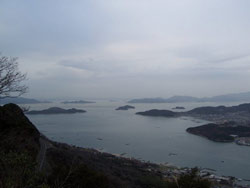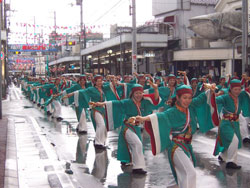
elloliamNiihama, Japan and Shikoku
 Let's talk about Shikoku! It's the smallest and cutest of the 4 main islands on Japan. The train system has only 1 connection to Honshu, 1 track, and does not form a complete loop around the island. Most people drive cars and live in houses. Neighborhoods are still cut with narrow streets, rivers and rice fields. Outside of the biggest cities local dialects thrive among all ages. Let's talk about Shikoku! It's the smallest and cutest of the 4 main islands on Japan. The train system has only 1 connection to Honshu, 1 track, and does not form a complete loop around the island. Most people drive cars and live in houses. Neighborhoods are still cut with narrow streets, rivers and rice fields. Outside of the biggest cities local dialects thrive among all ages.
There are four prefectures: Kochi, Tokushima, Kagawa and my home, Ehime. I lived in Niihama City for a year and a half, and recently took a new job in Matsuyama. As you've probably heard, Japanese people love the USA. Of course there's disagreement with Iraq and a bad history with the older generation but to young kids being from any English-speaking country is the damn coolest thing. All across Japan, hideous combinations like spaghetti with hot dogs in it and potato salad pizza are sold as imitations of American cooking. Corn dogs are "American Dogs." Japanese people are scared of America (huge black men with guns) and so they'll visit other places like Australia and Canada, but they all wish they had the guts to move to the US of A.
In general, Shikoku is a forgotten chunk of Japan. Most visitors from the main island, Honshu, are retired people doing a Buddhist pilgrimage. There are 88 famous temples around the perimeter of Shikoku in a set course. You visit them (usually in sequence) and get a special book stamped at each one. If you complete the journey in your lifetime, it's like reserving a seat in heaven.
Most people drive between the temples, or do it slowly on weekends, but you can still see many walking pilgrims on Shikoku. Usually they wear all white, hopefully with a hat and jacket, and most importantly a special walking stick. This stick represents the founder, Kobo Daishi, walking with you on your journey. The 1,200km hike takes most people around 6 weeks to complete. Some of the temples are very remote, some are next to a train station.
Often you can see a walking pilgrim begging for money downtown, ringing a bell and holding out an alms bowl. Of course, they also appreciate a meal and a place to stay. It's becoming more popular for young people to do the pilgrimage and discover their roots.
 Kochi is one of the few places where hunting/eating whale is traditional local culture. There are also dog fights, cock fights, a sweet castle, beaches and lots of mountains. Yosakoi Festival (August) is a dance festival. An endless parade of dance teams do their original song and dance behind their decorated float. While the songs have to have a comment element (saying "Yosakoi!") most of the teams have a modern style. Kochi dialect (Tosa-ben) is really hard for outsiders to understand. Kochi is one of the few places where hunting/eating whale is traditional local culture. There are also dog fights, cock fights, a sweet castle, beaches and lots of mountains. Yosakoi Festival (August) is a dance festival. An endless parade of dance teams do their original song and dance behind their decorated float. While the songs have to have a comment element (saying "Yosakoi!") most of the teams have a modern style. Kochi dialect (Tosa-ben) is really hard for outsiders to understand.
Tokushima means mountains and rivers. Iya Valley has nice terraced hillsides and a real vine bridge, Kazura-bashi, maintained (continuously rebuilt) since back in the day.
The best soba I've ever tasted was eaten here, and there is delicious food roasting on sticks. Awa Odori (August) is one of the most famous festivals in Japan. It's a traditional dance festival, and every team has a live band playing the official song. This festival is beautiful and fun. The dance style mimicks a stumbling drunk peasant on payday. "You're a fool if you dance, and you're a fool if you don't, so you might as well dance!"
Kagawa is the smallest prefecture in Japan. Most visitors go for... an udon tour! Carloads of people eat small servings of udon at as many restaurants as they can (usually 4~6.) 2006's movie, UDON, is about making an udon tour guidebook. The islands between Takamatsu (Shikoku) and Okayama (Honshu) traditionally had oni (man-eating ogres) on them. Shodoshima Island is famous for olives, and also has the world's largest statue of Kanon. Mr. Kobo Daishi of the 88 temples was born in Zentsu-ji city, and that temple is probably the fanciest on the course. This city now has a shockingly high number of love hotels because of the university and military base. There's no super famous festivals.
In Ehime we have mikan (mandarin oranges) and (used to have) pirates. Dogo Onsen in Matsuyama is the oldest operating hot spring in Japan. Mt. Ishizuchi is the tallest mountain on Shikoku and a brutal climb to the peak. Please ride a rental bike across Shimanami-Kaido, 77km of islands and bridges between Ehime and Hiroshima prefecture.
 The best things in Ehime are the festivals. Uwajima's Ushi-Oni (cow demon) festival is a lot like a Chinese dragon parade, and hosts the biggest bullfighting match in Japan. Matsuyama's mikoshi (small portable shrines) festival is very fast and violent. Saijo's danjiri (big wooden shrines) festival is drunken and beautiful. The best things in Ehime are the festivals. Uwajima's Ushi-Oni (cow demon) festival is a lot like a Chinese dragon parade, and hosts the biggest bullfighting match in Japan. Matsuyama's mikoshi (small portable shrines) festival is very fast and violent. Saijo's danjiri (big wooden shrines) festival is drunken and beautiful.
Niihama's taiko (big drums) festival is violent and beautiful and awesome and full of badass yakuza. This year is going to be special! Usually the city's 40 teams are divided by region, but every 10 years every team gets together for a ~*battle royale*~. The official competition is hoisting it in the air (really fucking hard) but rival neighborhoods prefer to ram the taiko floats together and crack their enemy's drum. Unlike America, there's no police safety lines separating the audience from the fights.
Japan still has a lot of rural areas, Shikoku will likely not have any great expansions in the future. It's rural, but not depressing. Anything about Japan usually takes place in Tokyo, but I've found the quieter areas to be more satisfying, unique and friendly. Most cities in Japan have an awesome festival, so please try to schedule one if you're planning a trip! And of course, it's always best if you can visit a local friend when you travel. Please consider Shikoku if you have the time to take things slow.
| 







